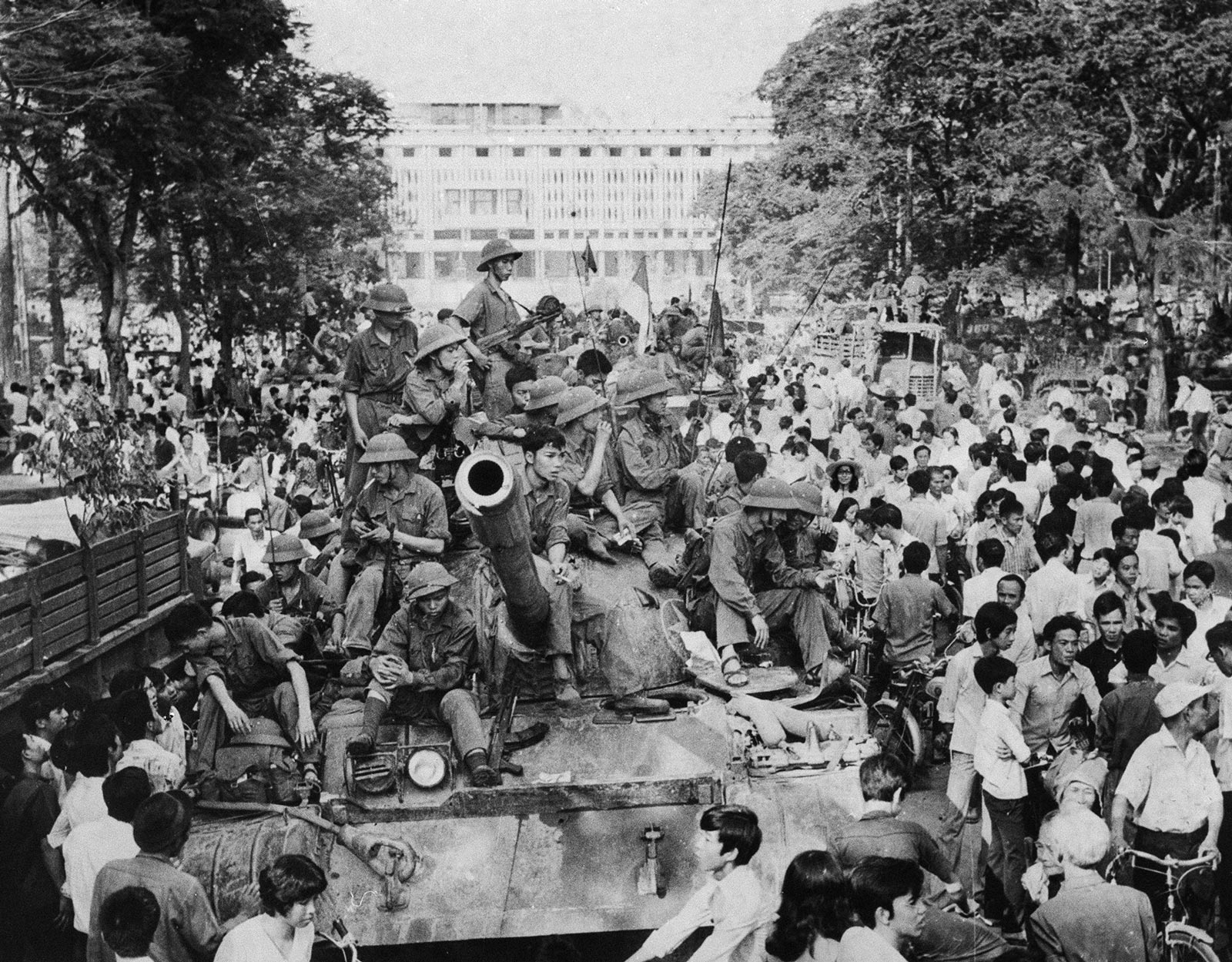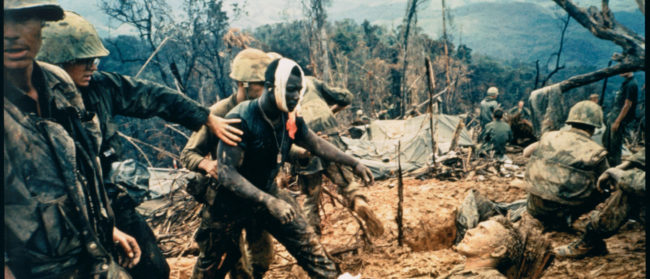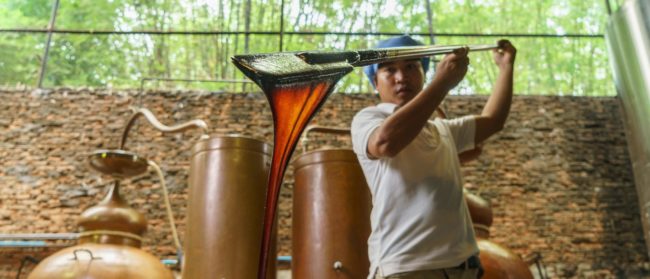When I think back to Vietnam in April 2019, Reunification Day opened with a bang across the country. For a week prior, Saigon’s District 1 was abuzz with activity. Stages and booths lined the promenade in front of the Rex Hotel as far as the eye could see from the hotel’s rooftop bar, filled with the echoes of five o’clock follies tinkling in the background.
In the week following 30 April 2019, I travelled up to Hanoi. There, the ring road surrounding Hoan Kiem Lake had closed down to become a circular amusement arcade for pedestrians. Late at night, in a crowd watching a music performance, a father held his small child in his arms, the young boy dressed in his pyjamas and sporting a hat embroidered with ‘USA’.

On 30 April 1975, both Saigon and Hanoi looked very different – they were very different. As Army of the Republic of Vietnam (ARVN) and American personnel fled Saigon, scrambling into Huey helicopters poised on the tops of buildings like dragonflies, People’s Army of Vietnam (PAVN) troops closed in on the city from all sides, meeting little resistance. In Hanoi, centre of the Democratic Republic of Vietnam’s (DRV) resistance to French colonialism followed by American imperialism, the population waited in the wreckage of a city fatigued by 30 years of war.
“What I remember the most is, at the end of 1974, I was called to Lộc Ninh to participate in a training course to learn about immediate and upcoming tasks,” said Trưóng Hiếu at his home on Hanoi in 2019. Hiếu, already in South Vietnam at the beginning of 1975 as a soldier and war artist, recalled the diminished morale of ARVN soldiers even then, worn down by control of village hamlets flip-flopping between them and the communist forces of the PAVN and the People’s Liberation Armed Forces (PLAF).
I needed to record Victory Day in Saigon. For example, daily activities of Saigon citizens. The city was not destroyed, there was no bathing in blood. Electricity was still on in the evenings so that people could go out and enjoy their night activities
Veteran journalist and North Vietnamese war artist Phạm Thanh Tâm
“One morning,” continued Hiếu, “the person in charge of the classes ordered all of us to gather for a meeting. When we were gathered together, he said, ‘Please go back to your units. The time has come. If you are late, you will miss it.’”
The order had been given; an attack on Saigon was imminent. Word would have travelled on the unbreakable messaging chain that had coordinated the communist DRV and National Liberation Front (NLF) war effort. However, for PAVN and PLAF forces ensconced in South Vietnam, how the attack would happen, or what it would look like, would have been kept secret.
“So, we returned to our units,” said Hiếu. “At that time, the atmosphere was already buzzing. One day when we were walking in the forest, we heard the sound of some tanks. We asked each other, ‘Damn, why is there the sound of tanks?’ Then one liaison agent said, ‘You guys stay here, I’ll go out and see.’ He ran out and then came back and said to us, ‘They’re our tanks!’ I saw the half blue half red flag [of the National Liberation Front].”
Hiếu and his unit approached Saigon from the southwest, floating across the Vàm Cỏ river in sealed tanks, and through Nhà Bè port. To the north, Nguyễn Thanh Châu joined a tank convoy travelling through the Plain of Reeds and the Mekong Delta’s mangrove forests. On location at the Ba Rem Canal crossing, Chau painted the convoy waiting for further orders. Another painting of his, dominated by the purple hues of a setting sun, shows the convoy of Soviet-built T-54 tanks marching through the outskirts of Saigon, forming part of the final attack on Saigon that would capture the city and end the war.


Veteran journalist and North Vietnamese war artist Phạm Thanh Tâm joined the attack on Saigon from the northeast. Tâm was in the unique position in that the Liberation of Saigon was not his first, but second, experience of victory in the struggle for independence.
He had been present when the guns stopped pounding at the Battle of Điện Biên Phủ almost exactly 21 years before, leaving a silence so unnaturally quiet that he heard a harmonica playing across the battlefield after victory over French colonialist forces.

Once inside Saigon, Tâm recounted a scene of surprising normality.
“As a battle journalist,” he said in an interview with Witness Collection in June 2017, “I needed to record the characteristics of Victory Day in Saigon. For example, daily activities of Saigon citizens. The city was not destroyed, there was no bathing in blood. Electricity was still on in the evenings so that people could go out and enjoy their night activities.”
Even so, for Tâm, the atmosphere was very different in Saigon compared to Hanoi, rampant commodity advertisements in stark contrast to Hanoi’s culture of utilitarianism. Tâm also noticed car makes he had never seen before, and the novel reverberations of Western nightclubs, which he found remarkable.


Trưóng Hiếu, as if in dream, decided to visit an attraction he had long heard about: the Saigon Zoo. Arriving at the zoo empty of visitors, he and his colleagues quickly found the zookeeper’s house, passing an enclosure with starving, emaciated tigers.
“We asked the zookeeper if he had anything to feed them,” said Hiếu. “He said, ‘No one brought them meat. Now I only have some chickens in my cage.’ So, I told him to bring the chickens out. He brought them out and we threw them into the tigers’ cage. The tigers got up and grabbed the chickens. They looked pitiful devouring the chickens. That day I thought I had the merit of saving those tigers.”
In the days after liberation, other artists flocked to the city. In one instance, two artists from opposite sides of the world converged on the porch of the Continental Hotel, looking out over the Opera House square at the Caravelle Hotel.
Stephan Koester, a filmmaker from the Federal Republic of Germany (West Germany), arrived in Saigon on behalf of North Vietnamese Prime Minister Phạm Văn Đồng on 27 April 1975, to document the victory of what he described in his film Erfolgsbericht as, “the better socialists of anywhere else fighting in Vietnam.” Nguyễn Ðức Thọ, a war artist from Hanoi, arrived in Saigon after liberation.
Koester had no grasp of the “encoded messages on the American radio that called upon foreigners and selected Vietnamese for the immediate evacuation by helicopters.”
That Saigon would fall in the coming days was an unbelievable notion to some, as Koester recounted the prediction of a Swedish journalist there at the time: “‘That might take a long time,’ he said. ‘Saigon is a long ways from being captured. Just because you are here now to film it, the 30 years’ war will not be over.’” The sounds of detonations on the horizon of an American ammunition depot exploding begged to differ.
A few days after liberation, Koester filmed Nguyễn Ðức Thọ sketching the Caravelle Hotel. To this day they remember the encounter fondly. Sitting in the Continental Hotel’s porch café with a friend, Thọ ordered a lager beer – at odds with the bia hơi (fresh beer) he normally had in Hanoi – and began to draw. “I also saw the reporter and other people taking pictures and speaking English,” said Thọ. “But later in his [Koester’s] letter, I found out that he was a reporter from West Germany. He was sympathetic to Vietnam and came to help Vietnam. He said they were all very precious memories.”
“I was polite and said hello, but we did not talk,” said Koester in an email interview in November 2019. “I would like to meet him again – have a beer or two.”




Film images of Nguyễn Ðức Thọ sketching the Caravelle Hotel, shot by Stephan Koester. Right: Thọ’s sketch. Credit: Witness Collection

Viewed from different angles, the Liberation of Saigon takes on many shades and hues. For those retreating from the city, the last glimpse of Saigon zooming away from above must have been a relief, as fear and anxiety of possible retribution melted away. For those marching alongside the reassuring rattle of tanks, the reality of getting closer to Saigon no doubt instilled a moment of pride and joy. For those meeting for the first time, to later reconnect in the future, the Fall of Saigon became a shared memory.
Nevertheless, the 45th anniversary of Reunification Day is no doubt a moment of celebration. Interestingly, in this time of Covid-19, it is also an important reminder of the way the world is developing. To date, more people have died in America from the coronavirus than American servicemen in the Vietnam War. Vietnam, on the other hand, has reported zero deaths so far.
So, to all those in Vietnam bravely and intelligently tackling the unprecedented pandemic as an independent nation, happy Reunification Day.


